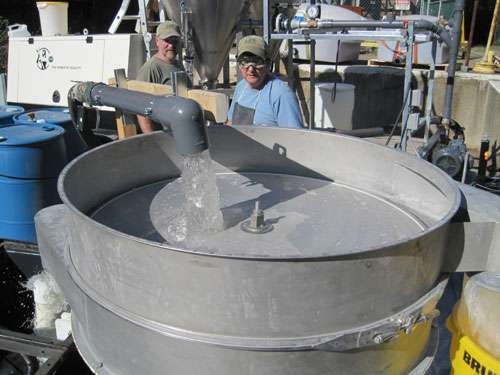Unexpected absorbent nanomaterial discovery leads to cleanup of hydrocarbons, pesticides and pharmaceuticals

Science is full of surprises. Chemist Paul Edmiston's search for a new way to detect explosives at airports instead led to the creation of what's now called "Osorb," swellable, organically-modified silica, or glass, capable of absorbing oil and other contaminants from water.
"The discovery of Osorb was serendipitous," says Edmiston, a chemistry professor at the College of Wooster in Wooster, Ohio. "It happened during basic science research, while I was investigating glasses that would bind with explosive vapors."
Edmiston was working on nano-engineered glass for explosives detection. His lab is composed of exclusively undergraduate students who were testing various methods of preparation at the time. During testing, one of the formulations instantaneously grew in size. That formulation became the first identified member of a now larger group of swellable silica-based materials.
"This is a good example of the value of basic scientific research, which is being conducted at undergraduate institutions across the nation," notes Edmiston.
Osorb is now the principal product of a company in Wooster called ABSMaterials, and Edmiston became the company's chief scientist. With support from the National Science Foundation (NSF), Edmiston and his colleagues at ABSMaterials are developing water remediation technologies for cities and industries—targeting everything from storm water to agricultural runoff.
"We made the decision to provide funding to ABSMaterials because of the potential for Osorb to have far-reaching impacts in enabling water purification. The project brings together a world-class technical team, led by Paul Edmiston, and a very exciting new material innovation," says Ben Schrag, program director in the division of industrial innovation and partnerships, within NSF's Directorate for Engineering.
Edmiston's introduction to ABSMaterials CEO Stephen Spoonamore was also serendipitous. Spoonamore knew about Edmiston's research, and when he spotted the professor on a plane, the CEO traded seats so they could talk. Their scientific and business association "took off" from there.
"I'd been asked to look at the challenges associated with the U.S. military working in remote locations. The biggest problem is not bullets. It's not bugs, guns or mines. It's water. How do you get enough water when you're out there alone? I had looked at the problem of contamination and didn't know of any good solutions," recalls Spoonamore.
"When you manufacture chips, electronics and chemicals, you need a lot of water," he continues. "You need to utilize that water in various ways. It becomes contaminated with volatiles; we can get those volatiles back out of the water."

Municipal water systems and companies in several U.S. states and Canadian provinces are now using Osorb. ABSMaterials is creating formulas to address various contaminants, including hydrocarbons, pharmaceuticals, pesticides, herbicides, chlorinated solvents and endocrine disruptors.
Edmiston says, chemically speaking, Osorb is halfway between the glass in a window and the silicone caulk in a bathtub. The glass is hard and the caulk is flexible.
"So, when Osorb expands and is absorbing something, it is not going through a traditional chemical reaction. Osorb is actually going through a mechanical expansion, sort of like the sponge in your kitchen, a nano-mechanical sponge," says Edmiston.
When Edmiston whipped up a batch of Osorb for the "Science Nation" team, the result was quick and dramatic. He combined several ingredients, including acetone, glass particles and a catalyst, and swirled them around in a beaker for a few seconds. Suddenly, there was a firm gel in the container.
"If we could get down inside the solution, the nanoparticles are being formed. They're starting to interconnect with each other. Until, eventually, the nanoparticles in here will connect up so much that they lock up," explains Edmiston, as he holds up the beaker. "So, after this fully connects and hardens up, we just dry it out down on the top and it shrinks down. Then, when it comes in contact with a contaminant, it will swell back up to take its original form."
Adding to Osorb's efficiency, says Edmiston, is that it can be re-used dozens of times. Absorbed compounds can be removed with heat, or rinsing.
While the first thing that may come to mind when thinking of removing oil from water is a disaster, such as the Deepwater Horizon oil spill in the Gulf of Mexico, Edmiston says there's an enormous need to clean up water that is part of the drilling process, known as "produced water."
"For every barrel of oil that we produce, probably, on average, 10 barrels of water comes out of the well. And, managing that water, which is going to contain hydrocarbons, is a challenge for our society. That's where Osorb fits in very well. So, in addition to cleaning up the occasional oil spill, we also need to clean up the water that is coming out of oil drilling and extraction every day," says Edmiston.
On the College of Wooster campus, Edmiston shows off a small garden, next to a parking lot, that's actually a working laboratory.
"This doesn't look like a place you'd find an advanced nanomaterial, such as Osorb. You were probably expecting more of a laboratory setting. But these garden plots are rain gardens that contain Osorb," explains Edmiston. "They are designed to treat the water that is coming from several nearby parking lots, buildings and a large lawn space. You have the stuff coming off the students' cars, including drops of oil, not to mention what could be in the garbage can. Without this rain garden, it would have gone into the street, and then into the creek."
Similar rain gardens are being used at other sites to clean water before it seeps back into the groundwater.
So far, Edmiston's unexpected discovery is finding many practical applications.
Provided by National Science Foundation

















